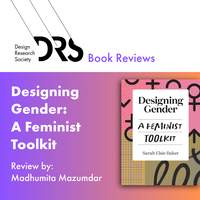
Book Details
Designing Gender: A Feminist Toolkit
Sarah Elsie Baker
Bloomsbury
2024
256 pp.,
83 illus.
ISBN: 9781350273740
Although appearing to be a fun and somewhat quirky practical resource for design students and young professionals, "Designing Gender: A Feminist Toolkit" by Sarah Elsie Baker is deeply anchored in serious scholarly debates on feminist science, technology, philosophy and design. The book draws upon feminist and queer theory and deploys an expansive notion of design that traverses many fields including product, textile and visual communication design, interface and interaction design, and more importantly craft. Rather than prescriptive, the toolkit is surprisingly dialogic.
Baker's position as a UK-born scholar and a Senior Lecturer and Research Fellow at Media Design School in Auckland, New Zealand allows her to take a scholarly perspective that draws upon the rich cross-cultural debates on design that took shape in countries with large indigenous populations. It is somewhat rare to find a book emanating from the Anglo-European publishing world that speaks so compellingly to design sensibilities rooted in indigenous knowledge systems and cosmologies. Baker's polemical intervention in this sense is less reformist and more radical in a positive sense. Yet this radical gesture is sustained in a grounded and engaged manner amenable to the lived experiences of undergraduate students or young professionals engaged in design practice. Designing Gender begins each chapter with foundational concepts and keywords in feminist scholarship and then complicates each definition by weaving in queer and intersectional perspectives.
The book has six chapters and an epilogue. These focus on the complexities of sex and gender in terms of definitions and debates as well as their entrenched location in pervasive structures of oppression. The opening chapter, for instance discusses how things are gendered and how to read these through the 'scripts' that accompany them. Apart from traversing the theoretical ground of each concept, each chapter includes an interview with scholar, practitioner or activist committed to breaking norms and charting new conceptual paths. There are also at the end of each chapter two recommended activities. In this one, a "gender journal" and "gender norm" discussion cards. These activities are meant to bring theory into the more intimate and affective spaces of learning and help students internalise what at times might seem abstract or distant.
This is the structure of all the chapters, as each builds upon and broadens the themes discussed in the previous ones. Chapter two titled, ‘Women, Craft and Technology’, for example, raises the question of the narrow and gendered remit of design histories that exclude craft as a subject of inquiry. Baker questions this exclusion and synthesises a body of feminist scholarship that looks at craft as feminist resistance. Chapter three takes a deep dive into women in the professional space of Design and uncovers the gendered norms of workplace culture, of accreditation and authorship and the general challenge of contending with hegemonic masculinity. She interviews a graphic designer and co-founder of the feminist designer social club, SEOL and includes a case study addressing inequality in the workplace, focussing on Catherine Griffith of Aotearo New Zealand. What is interesting at the end of this chapter are the two activities: the first a "Situated Knowledge Map" and second a "Listening Positionality Exercise." Both are intended to address the problem of reflexivity for young designers. How aware are we of our social locations, our positions of privilege when we enter the field of design and how do these social positions impact our ways of perceiving the social realities? How do our blind spots emerge from the positions through which we see the world? The "Listening Positionality" exercise also alerts us to the problem of how our social locations condition our habits of listening and tests this out with an exercise. Readers are asked to get together with a friend or a colleague and give them sixty seconds to rant about something that irks them. At the end of the sixty seconds, the listener is supposed to have figured out what their colleague or friend cared about, what they value or what they believed in. They are then asked to reflect on their answers and ask themselves how their positionality i.e gender, cultural background etc, influenced their listening capacities, habits or biases.
The fourth, fifth and sixth chapters open up the arena of discussion from the immediate workplace to society, to contemporary global ecological challenges and to futures and asks how queering our ways of looking at the world might help us transcend the limits of the binary codes that structure our perception of the human and natural world. Chapter Five, titled ‘Feminist Design Futures’, discusses a wide range of 'futuring' possibilities under the rubric of speculative design, design fictions and queer -feminist visions of the future.
Chapter Six brings together a discussion of sustainable design practice through non-binary design and indigenous worldviews. The previous chapters' case for a queering of design practice is braided into a discussion of the relational epistemologies and cosmologies of indigenous people wherein all forms of life are in perpetual states of mutation and interconnection. It is this fluid, relational and post-human dwelling in the world that lies at the heart of Baker's queer feminist practice and her design toolkit.
The book brings clarity and focus to queer feminist design and outlines its agenda with both rigour and compassion. Baker's call is to explore how gender norms are created through design practice and uncover those that hinder our quality of life. The starting point of this agenda is to rethink the very definition of design that emerged through industrialization and the extractive economic systems that sustained it. The task is not just to make hegemonic masculinities or gender inequality visible, but to disrupt every entrenched habit that occludes critical awareness of it. For it is only by conceding the limits of our 'situated knowledges' and by embracing diversity that we can hope to co-create feminist visions of the future that value our interconnections with non-humans and the rich relational worlds we inhabit.
Madhumita Mazumdar is faculty in the Humanities and Social Sciences at the Dhirubhai Ambani University, Gandhinagar, India. Her research interests are in social and cultural histories of Science, Technology and Design. She also does collaborative research with Prof. Vishvajit Pandya in colonial and post- colonial histories of the Andaman Islands. She is co- author of the book titled, "New Histories of the Andaman Islands: Place, Space and Identity in the Bay of Bengal, 1790-2012" published in 2016 by the Cambridge University Press, UK 2016. Currently she has a book contract with Bloomsbury Press, UK to work on the early career of design pedagogy and progressive education at the National Institute of Design, India.
